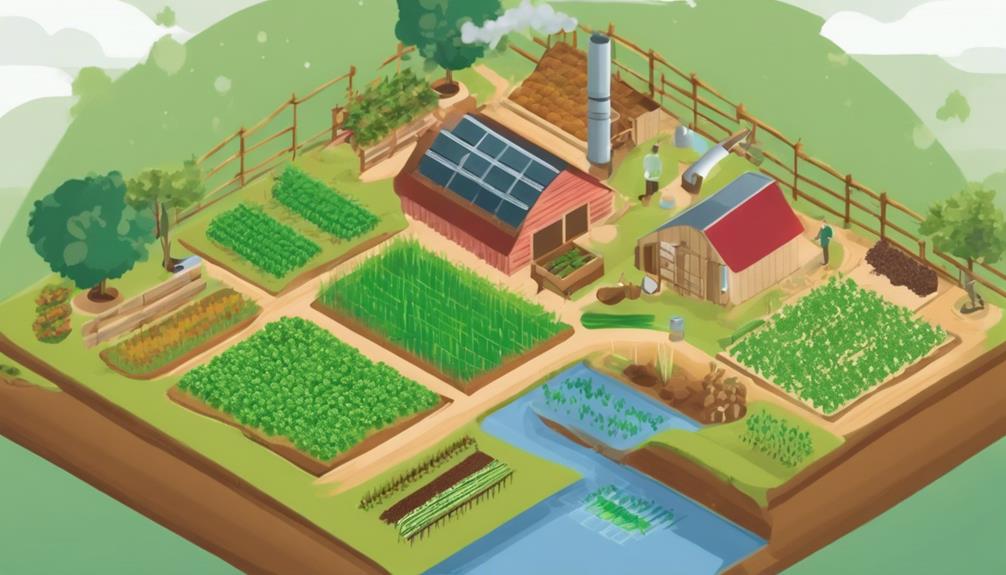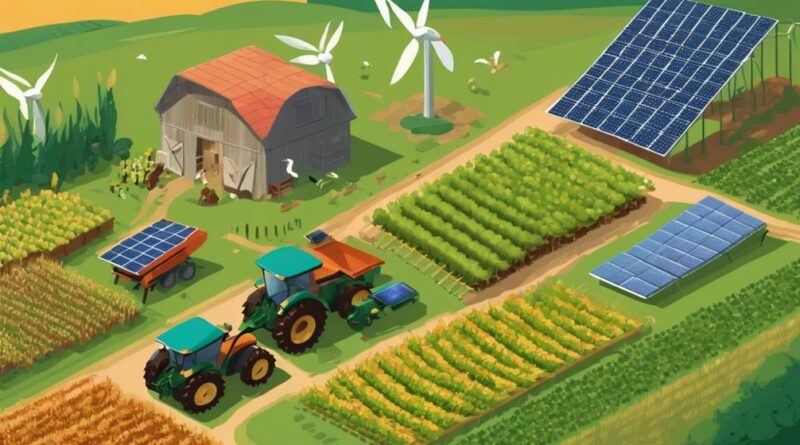7 Best Ways to Reduce Agriculture's Carbon Footprint
You may not be aware that agriculture contributes significantly to carbon emissions globally. However, there are effective ways you can reduce agriculture's carbon footprint.
From implementing agroforestry practices to embracing precision agriculture techniques, these strategies can play a crucial role in mitigating greenhouse gas emissions.
By making simple yet impactful changes in farming methods and resource management, you can actively contribute to a more sustainable and environmentally friendly agricultural sector.
Implementing Agroforestry Practices
By integrating trees into your agricultural practices, you can significantly reduce your carbon footprint through agroforestry. Trees play a vital role in sequestering carbon dioxide from the atmosphere, helping to mitigate the impacts of climate change. When you incorporate trees within your farming systems, you not only contribute to carbon sequestration but also enhance biodiversity on your land.
Integrating trees into your agricultural practices offers numerous benefits beyond just carbon sequestration. Trees provide habitats for various wildlife species, including birds, insects, and small mammals. This increase in biodiversity can lead to a more balanced and resilient ecosystem on your farm. Additionally, trees help improve soil health by reducing erosion, enhancing water retention, and promoting nutrient cycling.
Utilizing Cover Crops Strategically
To strategically enhance carbon sequestration and soil health in your agricultural practices, consider utilizing cover crops. Cover crops play a crucial role in crop diversification, enhancing soil health, and promoting carbon sequestration while aiding in water conservation. By incorporating cover crops into your farming rotation, you can significantly reduce your farm's carbon footprint and improve overall sustainability.
Crop diversification is essential for maintaining soil health as different cover crops bring unique benefits to the soil. Leguminous cover crops, such as clover or vetch, fix nitrogen into the soil, reducing the need for synthetic fertilizers and promoting healthier plant growth. Meanwhile, grass cover crops like rye or barley help prevent soil erosion, retain moisture, and suppress weed growth, further enhancing soil health.
Moreover, cover crops play a vital role in carbon sequestration by capturing and storing atmospheric carbon in the soil. This process not only helps mitigate climate change by reducing greenhouse gas emissions but also improves soil structure and fertility over time. Additionally, the root systems of cover crops enhance water conservation by increasing soil infiltration rates and reducing surface runoff, thus minimizing water loss and improving overall water efficiency in your agricultural operations.
Embracing No-Till Farming Methods
Consider adopting no-till farming methods to minimize soil disturbance and enhance carbon sequestration in your agricultural practices. No-till farming involves planting crops without plowing the soil, leaving crop residues on the field after harvest, which helps improve soil health and reduce erosion. Here are three key benefits of embracing no-till farming methods:
- Soil Conservation:
No-till farming helps to protect the soil structure by reducing erosion and preserving essential soil nutrients. By avoiding tilling, you maintain the soil's natural composition, promoting better water retention and enhancing overall soil health.
- Carbon Sequestration:
One of the significant advantages of no-till farming is its ability to enhance carbon sequestration. By leaving crop residues on the field, the organic matter decomposes slowly, storing carbon in the soil rather than releasing it into the atmosphere. This process helps mitigate climate change by reducing greenhouse gas emissions.
- Improved Soil Health:
Embracing no-till farming practices can lead to improved soil health over time. The presence of organic residues on the soil surface provides a food source for beneficial soil organisms, promoting biodiversity underground. This healthier soil ecosystem results in better crop yields and long-term sustainability for your agricultural operations. By adopting no-till farming methods, you not only contribute to soil conservation and carbon sequestration but also invest in the future productivity of your farm.
Introducing Rotational Grazing Systems
Implementing rotational grazing systems can significantly benefit agricultural sustainability and livestock health. By dividing pastures into smaller sections and rotating livestock between them, you can improve grazing efficiency and promote sustainable pastures. Rotational grazing allows for better utilization of forage, as animals graze in one area while other sections have time to regrow. This method helps prevent overgrazing, reducing soil erosion and promoting healthier grass growth.
Furthermore, rotational grazing can lead to increased biodiversity in pastures, enhancing soil health and nutrient cycling. Livestock are moved frequently, preventing the buildup of parasites and diseases in concentrated areas. This practice also mimics natural grazing patterns of wild herbivores, contributing to a more balanced ecosystem.
Improving Soil Health Through Composting
Improving soil health through composting can significantly enhance agricultural sustainability and productivity. By incorporating composting practices into your farming routine, you can reap numerous benefits that positively impact both the environment and crop yields.
Here are three key ways composting improves soil health:
- Enhancing Microbial Diversity: Composting introduces a diverse array of beneficial microorganisms into the soil. These microbes play a crucial role in nutrient cycling and soil structure. They help break down organic matter, making essential nutrients more accessible to plants. As a result, your crops are healthier and more resilient to stressors like pests and diseases.
- Promoting Nutrient Cycling: Compost is rich in nutrients that plants need to thrive, such as nitrogen, phosphorus, and potassium. By composting, you're recycling organic matter back into the soil, enriching it with essential nutrients. This reduces the need for synthetic fertilizers, which can leach into water sources and contribute to greenhouse gas emissions.
- Mitigating Greenhouse Gases: Composting organic materials instead of sending them to landfills helps reduce methane emissions, a potent greenhouse gas. Additionally, healthy soils act as carbon sinks, sequestering carbon dioxide from the atmosphere and mitigating climate change.
Incorporating composting into your agricultural practices is a simple yet powerful way to improve soil health, increase crop productivity, and reduce agriculture's carbon footprint.
Adopting Precision Agriculture Techniques
Embracing precision agriculture techniques revolutionizes farming practices by maximizing efficiency and optimizing resource utilization. One key aspect of precision agriculture is the use of advanced soil mapping technologies. These technologies allow farmers to accurately assess the variability in soil properties across their fields. By understanding these variations, farmers can tailor their management practices more precisely, such as adjusting fertilizer application rates based on specific soil needs.
Another vital component of precision agriculture is the implementation of variable rate applications. Instead of applying a uniform amount of inputs across an entire field, farmers can now utilize technology to apply inputs, like fertilizers or pesticides, at variable rates based on the specific requirements of different zones within the field. This targeted approach not only ensures that crops receive the optimal amount of inputs they need but also helps reduce wastage and minimize environmental impact.
Enhancing Water Management Strategies

To optimize agricultural practices and reduce water wastage, consider implementing efficient water management strategies. When it comes to enhancing water management on your farm, there are several key steps you can take to improve irrigation efficiency and promote drought resistance.
Here are three essential strategies to enhance water management:
- Invest in Drip Irrigation Systems: Drip irrigation is a highly efficient method that delivers water directly to the roots of plants. By minimizing water loss through evaporation or runoff, drip irrigation helps conserve water and ensures that crops receive an adequate amount of moisture for optimal growth.
- Implement Rainwater Harvesting Techniques: Harvesting rainwater can supplement irrigation needs, especially during dry periods. By collecting and storing rainwater, you can reduce dependency on freshwater sources and promote sustainable irrigation practices on your farm.
- Adopt Soil Moisture Monitoring Technology: Utilizing soil moisture sensors can help you track the moisture levels in the soil accurately. This data allows you to adjust your irrigation schedule based on the actual water needs of your crops, leading to more efficient water usage and improved drought resistance.
Investing in Renewable Energy Sources
Consider incorporating solar panels to power your agricultural operations and reduce carbon emissions. Solar power integration offers cost-effective solutions for farmers looking to reduce their carbon footprint. By harnessing the power of the sun, you can generate electricity to run irrigation systems, lighting, and other farm operations, all while decreasing reliance on fossil fuels.
In addition to solar power, wind energy implementation can provide ecological benefits to your agricultural practices. Installing wind turbines on your land can help generate clean, renewable energy to supplement your power needs. Wind energy is a sustainable option that can further reduce your farm's carbon emissions and contribute to a greener environment.
Investing in renewable energy sources like solar and wind power not only helps the environment but can also lead to long-term cost savings for your agricultural operations. While the initial investment may require some financial outlay, the long-term benefits in terms of reduced energy costs and environmental impact make it a wise choice for sustainable farming practices.
Frequently Asked Questions
How Can Government Policies and Regulations Help Incentivize Farmers to Adopt More Sustainable Practices?
To encourage farmers to adopt sustainable practices, government incentives play a crucial role. By offering subsidies and tax breaks for sustainable agriculture methods, policymakers can motivate you to make eco-friendly choices. These incentives can offset the initial costs of transitioning to more sustainable practices, making it a financially attractive option.
Additionally, regulations can be put in place to ensure compliance and create a level playing field for all farmers.
What Role Do Consumer Choices and Demand Play in Influencing Agricultural Practices and Reducing Carbon Emissions?
When it comes to influencing agricultural practices and reducing carbon emissions, consumer choices and demand play a crucial role. Consumer education can guide decisions towards sustainable options, while market trends respond to these preferences.
Are There Any Specific Challenges or Barriers That Farmers Face When Trying to Implement These Sustainable Practices?
When trying to implement sustainable practices, farmers face various challenges like high initial costs and lack of access to resources. However, there are solutions available to overcome these obstacles.
Collaborating with agricultural organizations for funding and support can help address financial barriers. Additionally, educational programs and government incentives can provide valuable resources and guidance to aid in the transition towards more sustainable farming practices.
How Can Small-Scale and Family-Run Farms Effectively Reduce Their Carbon Footprint Compared to Larger Commercial Operations?
To effectively reduce your carbon footprint on a small-scale or family-run farm, focus on implementing sustainable practices. By optimizing efficiency in your operations, regardless of farm size, you can have a significant impact.
Consider practices like crop rotation, reducing waste, and utilizing renewable energy sources. These steps not only benefit the environment but also contribute to the long-term sustainability of your farm.
What Are Some Innovative Technologies or Tools That Can Assist Farmers in Monitoring and Reducing Their Greenhouse Gas Emissions?
To monitor and reduce greenhouse gas emissions, consider using smart sensors and data analytics for precise insights. Embrace precision farming and automation technologies to streamline your operations efficiently.
These tools help you track emissions, optimize resource usage, and make data-driven decisions. By incorporating these innovative technologies into your farming practices, you can effectively monitor and reduce your carbon footprint while maximizing productivity.
Conclusion
By implementing these 7 strategies, you can significantly reduce agriculture's carbon footprint. Embrace agroforestry, cover crops, no-till farming, rotational grazing, composting, precision agriculture, and water management.
Invest in renewable energy sources to further enhance sustainability. Make a positive impact on the environment and contribute to a greener future for agriculture.
Start implementing these practices today and be part of the solution to combat climate change.
